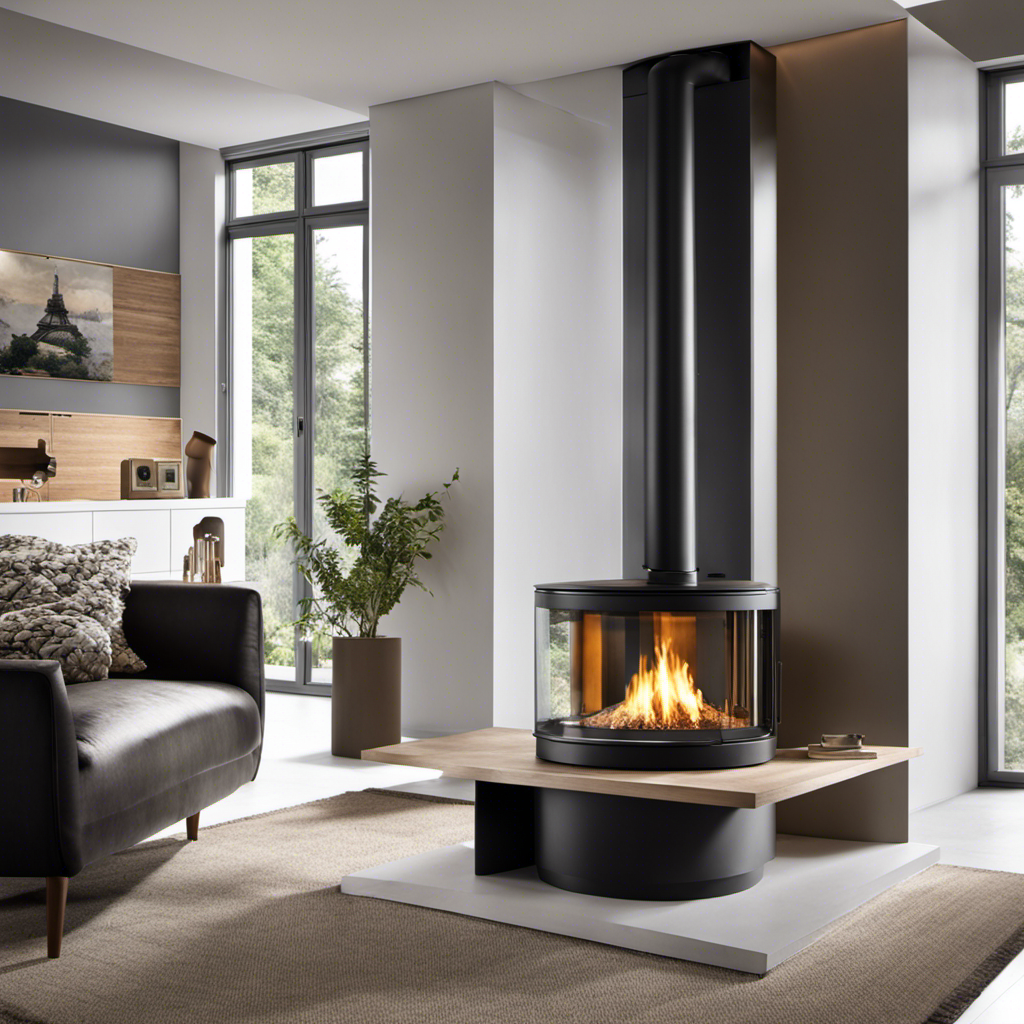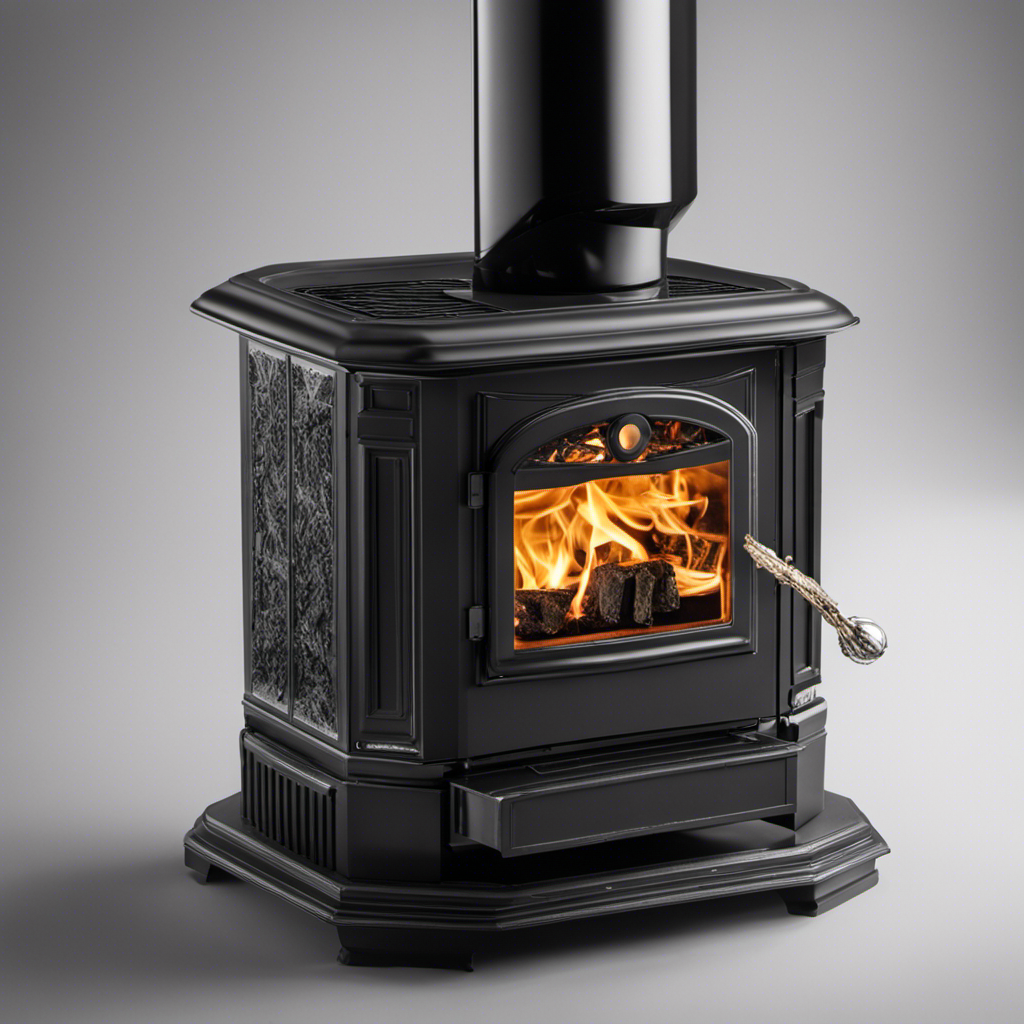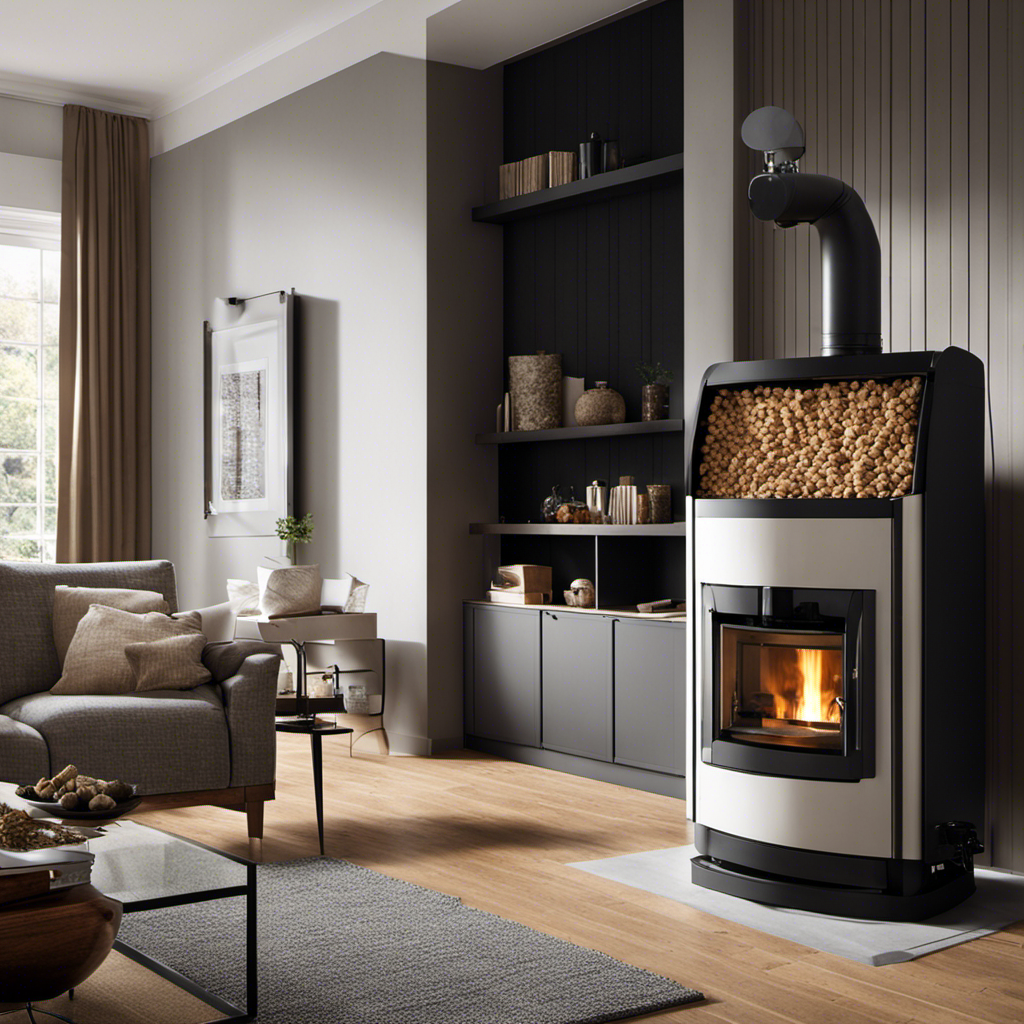As we explore the realm of biomass pellet stoves and their transformative impact on corn burning, an intriguing comparison emerges.
Just as the demand for renewable energy grows, these stoves are emerging as a promising solution. Designed to handle corn, they offer benefits like burning organic alternatives and increased ash space.
Join us as we explore the exciting possibilities of biomass pellet stoves and their potential to shape the future of sustainable heating.
Key Takeaways
- Biomass pellet stoves are specifically designed to handle corn and ensure complete burning.
- Biomass pellet stoves offer versatility in pellet options, allowing for the burning of normal pellets, corn, and compressed biomatter.
- Biomass pellets are cost-effective to produce and are cheaper to buy compared to normal pellets.
- Biomass pellets can be sourced from various materials, making them a sustainable and renewable fuel option for pellet stoves.
The Advantages of Biomass Pellet Stoves for Burning Corn
We find that biomass pellet stoves offer numerous advantages when it comes to burning corn. When comparing the efficiency of biomass pellet stoves for corn burning, we see that these stoves are specifically designed to handle corn, ensuring complete burning and minimizing any potential issues.
Unlike normal pellet stoves, biomass pellet stoves have a constant input from the electric element, which means they can efficiently burn corn at lower temperatures. Additionally, biomass pellet stoves have more space for ash and stronger or larger parts to handle the unique burning characteristics of corn.
Another benefit of using biomass pellet stoves for corn is that biomass pellets are cost-effective to produce and cheaper to buy compared to normal pellets.
With their versatility and cost-effectiveness, biomass pellet stoves are the ideal choice for burning corn.
Understanding the Differences: Corn Pellets Vs. Normal Pellets
When comparing corn pellets to normal pellets, it’s important to understand the differences in burning temperature and moisture content.
Corn burns at lower temperatures compared to normal pellets. Additionally, corn may still contain moisture, which affects its burning efficiency.
In biomass pellet stoves, the heating element needs to be used more when burning corn pellets. However, pellet stoves designed specifically for corn ensure complete burning.
On the other hand, normal pellet stoves may not be able to burn corn due to their reliance on air pressure from the fan and the potential clogging from biomass. Biomass pellet stoves, on the other hand, are designed to handle corn and have more space for ash.
The pros and cons of using corn pellets in biomass pellet stoves include cost-effectiveness, versatility in pellet options, and the need for specific stove designs.
Further research is needed to determine the comparison of burning efficiency between corn pellets and normal pellets in biomass pellet stoves.
Why Some Pellet Stoves Can’t Handle Corn: Explained
After researching the topic, it became clear that certain stoves can’t handle corn due to their reliance on air pressure and potential clogging from other materials. When comparing the efficiency of biomass pellet stoves with traditional pellet stoves, there are pros and cons of using corn as a fuel source in pellet stoves.
Pros of using corn as a fuel source:
- Cost-effective: Corn pellets are cheaper to produce and buy compared to traditional pellets.
- Versatility: Biomass pellet stoves designed for corn offer the option to burn various organic pellet alternatives.
- Cheaper alternative: With the rising cost of traditional pellets, corn provides a more affordable solution.
Cons of using corn as a fuel source:
- Lower temperature: Corn burns at lower temperatures than traditional pellets, requiring the heating element in the pellet stove to be used more.
- Moisture content: Corn may still contain moisture, affecting the burning process and efficiency.
- Limited compatibility: Normal pellet stoves rely on air pressure and can become clogged by biomass, making them unsuitable for burning corn.
Key Features and Capabilities of Biomass Pellet Stoves
One important aspect to consider is the size and strength of the parts in these pellet stoves. Biomass pellet stoves have stronger or larger parts compared to traditional pellet stoves. This is because biomass pellet stoves are designed to handle corn and other organic pellet alternatives. They’ve more space for ash and are able to burn different types of pellets, including normal pellets and compressed biomass. This versatility in pellet options is one of the benefits of using biomass pellet stoves.
Additionally, using corn pellets in pellet stoves has its own advantages. Corn is cost-effective to produce and cheaper to buy compared to normal pellets. It can be sourced from various materials, making it a sustainable and renewable fuel option.
When it comes to maintenance, biomass pellet stoves require regular cleaning and inspection to ensure efficient operation and prevent any issues.
Types of Pellets Compatible With Biomass Pellet Stoves
Another option for fuel in these types of pellet stoves is compressed biomatter, which offers versatility in pellet options. Biomass pellet stoves are specifically built to handle corn, making it one of the types of biomass that can be burned in these stoves.
In addition to corn, biomass pellet stoves can also burn normal pellets, providing flexibility for users.
The benefits of corn burning in biomass pellet stoves are numerous. Firstly, normal pellets have become more expensive, while biomass pellets are cost-effective to produce and cheaper to buy.
Secondly, biomass pellets can be sourced from various materials, making them a sustainable and renewable fuel source.
Lastly, biomass pellets are safe to use in pellet stoves, providing users with peace of mind.
The Cost Benefits of Using Biomass Pellet Stoves
When it comes to using biomass pellet stoves, there are significant cost benefits to consider.
One of the main advantages is the potential for cost savings. Biomass pellets are generally cheaper to produce compared to traditional pellets, making them a more affordable option for consumers. Additionally, biomass pellets can be sourced from various materials, such as agricultural waste or wood scraps, which can further reduce costs.
Another important aspect to consider is the environmental impact. Biomass pellets are considered to be a renewable energy source, as they’re derived from organic materials. By using biomass pellet stoves, individuals can reduce their carbon footprint and contribute to a more sustainable future. Furthermore, biomass pellets produce lower emissions compared to fossil fuels, which can help improve air quality and reduce the negative effects of climate change.
Overall, the cost benefits and environmental impact of using biomass pellet stoves make them an attractive option for those looking to save money and reduce their environmental footprint.
Safety Considerations When Burning Corn With Biomass Pellet Stoves
Using a biomass pellet stove to burn corn requires careful attention to safety considerations. When using corn as a fuel source in a biomass pellet stove, there are a few safety precautions and maintenance tips to keep in mind.
-
Ensure proper ventilation in the area where the stove is located to prevent the buildup of harmful gases.
-
Regularly clean the stove to remove any ash or debris that may accumulate during the burning process.
-
Inspect the stove’s components, such as the auger and combustion chamber, to ensure they’re in good working condition.
How Biomass Pellet Stoves Contribute to Sustainable Heating
Sustainable heating is an important aspect of our energy consumption. Biomass pellet stoves offer an environmentally friendly solution by utilizing renewable energy sources and reducing emissions.
These stoves burn organic pellet alternatives, such as corn, which are considered renewable because they can be replenished. By using biomass pellets, we can reduce our reliance on fossil fuels and decrease our carbon footprint.
Biomass pellet stoves are designed to handle corn and other biomass materials, providing a versatile option for heating. Additionally, biomass pellets are cost-effective to produce and cheaper to buy compared to traditional pellets. They can be sourced from various materials, making them a sustainable choice for long-term heating solutions.
Enhancing Efficiency: Tips for Burning Corn in Biomass Pellet Stoves
To maximize efficiency, we can ensure that the heating element in our biomass pellet stoves is used more when burning corn. This can be achieved by following these burning techniques and maintenance tips:
-
Adjust the settings: Increase the temperature and fan speed to optimize corn combustion.
-
Clean the stove regularly: Remove any clogs or debris that may hinder the burning process.
-
Use high-quality corn pellets: Ensure that the pellets are dry and free from moisture to promote complete burning.
By implementing these tips, we can enhance the efficiency of our biomass pellet stoves when burning corn. This will result in a more effective and sustainable heating solution.
Exploring the Versatility of Biomass Pellet Stoves in Fuel Options
When it comes to fuel options for biomass pellet stoves, there’s a remarkable versatility that allows users to explore alternative biomass fuels. One important aspect to consider is the understanding of moisture content in different fuel sources. Biomass fuels can vary in moisture content, and this can affect the burning efficiency of the pellet stove. It’s crucial to choose biomass fuels with low moisture content to ensure optimal performance and minimize the risk of issues such as clogging or incomplete combustion.
Additionally, exploring alternative biomass fuels opens up opportunities for utilizing a wide range of organic materials, such as wood chips, agricultural residues, or even dedicated energy crops. By expanding the options for biomass fuels, users can find cost-effective and sustainable alternatives to traditional pellet options, making biomass pellet stoves an even more attractive choice for heating solutions.
The Impact of Biomass Pellet Stoves on the Corn Industry
As consumers, we’ve witnessed the significant impact of biomass pellet stoves on the corn industry. These stoves have brought about both economic and environmental benefits.
-
The economic impact: Biomass pellet stoves have provided a new market for corn farmers, increasing the demand for corn as a renewable energy source. This has led to higher profits for farmers and a boost to the local economy.
-
The environmental benefits: Biomass pellet stoves burn corn pellets, which are a renewable and sustainable fuel source. By using corn instead of traditional fossil fuels, biomass pellet stoves reduce greenhouse gas emissions and contribute to a cleaner environment. Additionally, corn pellets are a byproduct of the corn industry, utilizing a waste product and reducing overall waste.
Overall, the rise of biomass pellet stoves hasn’t only had a positive economic impact on the corn industry but has also contributed to the environmental sustainability of our energy consumption.
The Future Outlook: Advancements in Biomass Pellet Stove Technology
With advancements in technology, we can expect even more efficient and sustainable heating options for our homes. The future market trends for biomass pellet stoves are promising, as researchers and engineers continue to develop new technologies to enhance their performance.
These advancements include improvements in combustion efficiency, automation features, and integration with smart home systems. By optimizing the combustion process, biomass pellet stoves can achieve higher heat output while consuming less fuel, making them more energy-efficient.
Automation features such as programmable timers and remote control capabilities allow homeowners to easily control and monitor their heating systems. Additionally, the integration of biomass pellet stoves with smart home systems enables seamless integration with other energy-saving devices and provides homeowners with real-time energy consumption data.
These advancements in technology won’t only enhance the user experience but also contribute to a more sustainable and eco-friendly future.
How Do Biomass Pellet Stoves Compare to Traditional Stoves in Terms of Efficiency and Savings?
Biomass pellet stoves are more efficient than traditional stoves, offering significant savings on heating costs. The powerful pellet stoves have a higher combustion rate, producing more heat with less fuel. This results in greater energy efficiency and reduced fuel consumption, ultimately leading to cost savings for homeowners.
Can Wood Chips be Used as Biomass Fuel in Pellet Stoves?
Yes, wood chips for stove can be used as biomass fuel in pellet stoves. Wood chips are a sustainable and cost-effective option for heating, as they can be produced from waste wood or harvested from sustainable forestry practices. When used in pellet stoves, wood chips can provide a reliable and efficient source of heat.
Frequently Asked Questions
Can Biomass Pellet Stoves Burn Normal Pellets as Well as Corn?
Yes, biomass pellet stoves can burn both normal pellets and corn. These stoves are designed to handle alternative fuels, offering versatility in pellet options.
While normal pellets have become more expensive, biomass pellets are cost-effective to produce and cheaper to buy. They can be sourced from various materials and are safe to use in pellet stoves.
Biomass pellet stoves are a sustainable and efficient solution for burning pellets and provide an environmentally friendly alternative to traditional heating methods.
What Are the Safety Considerations When Burning Corn With Biomass Pellet Stoves?
Safety precautions and maintenance requirements should be considered when burning corn with biomass pellet stoves.
It’s important to ensure proper ventilation to prevent the buildup of carbon monoxide.
Regular cleaning of the stove and chimney is necessary to prevent the accumulation of creosote, which can cause chimney fires.
Additionally, proper storage of corn pellets is crucial to prevent moisture and mold growth.
Following these precautions and performing regular maintenance will ensure safe and efficient operation of biomass pellet stoves when burning corn.
How Do Biomass Pellet Stoves Contribute to Sustainable Heating?
Biomass pellet stoves contribute to sustainable heating by offering energy efficiency and environmental benefits. These stoves are designed to burn organic pellet alternatives, such as corn, which are cost-effective to produce and cheaper to buy compared to normal pellets.
Biomass pellets can be sourced from various materials, making them a versatile and renewable fuel option. With their efficient burning process and reduced emissions, biomass pellet stoves help reduce our carbon footprint and promote a greener, more sustainable future for heating.
What Are Some Tips for Enhancing Efficiency When Burning Corn in Biomass Pellet Stoves?
Enhancing efficiency when burning corn in biomass pellet stoves involves several key techniques.
First, ensure proper fuel quality by using dry corn pellets with low moisture content.
Next, adjust the stove’s settings to optimize combustion efficiency and minimize waste.
Regular cleaning and maintenance of the stove’s components, such as the burn pot and exhaust system, is also crucial.
Lastly, consider using a stove with advanced features like adjustable air intake and programmable timers to further enhance efficiency.
How Do Biomass Pellet Stoves Impact the Corn Industry?
Biomass pellet stoves have a significant impact on the corn industry. By providing an alternative use for corn, they create a new market for corn farmers, boosting their income and supporting the agricultural economy.
The economic benefits of biomass pellet stoves extend beyond the corn industry, as they offer cost-effective heating options for consumers. Additionally, biomass pellets can be sourced from various materials, reducing reliance on traditional fossil fuels and promoting sustainable practices.
Overall, biomass pellet stoves contribute to the growth and sustainability of the corn industry.
Conclusion
In conclusion, biomass pellet stoves have emerged as a game-changing solution for efficient and sustainable heating, particularly when it comes to burning corn.
The advantages and capabilities of these stoves, such as their ability to handle organic pellet alternatives and their larger ash space, make them a promising option in today’s changing energy landscape.
With advancements in biomass pellet stove technology, one can’t help but wonder: Will these stoves pave the way for a greener and more sustainable future?
Growing up surrounded by the vast beauty of nature, Sierra was always drawn to the call of the wild. While others sought the comfort of the familiar, she ventured out, embracing the unpredictable and finding stories in the heartbeat of nature.
At the epicenter of every remarkable venture lies a dynamic team—a fusion of diverse talents, visions, and passions. The essence of Best Small Wood Stoves is crafted and refined by such a trio: Sierra, Logan, and Terra. Their collective expertise has transformed the platform into a leading authority on small wood stoves, radiating warmth and knowledge in equal measure.











